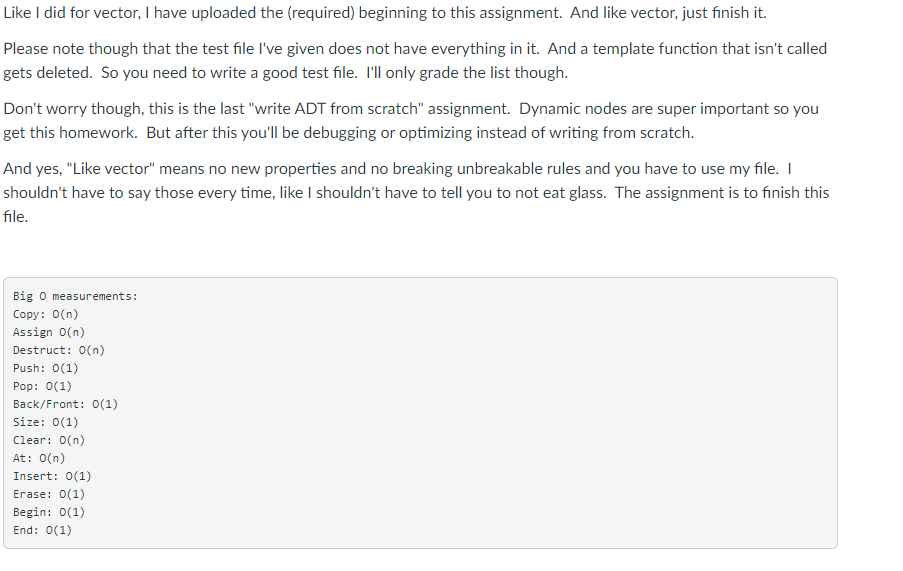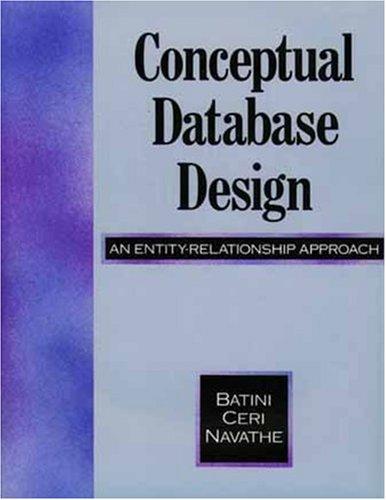Question
Complete the h.file to output with main #pragma once template class List { struct ListNode { ListNode() { } T mData; ListNode* mPrev; ListNode* mNext;

Complete the h.file to output with main
#pragma once template
ListNode* mHead; ListNode* mTail; mutable T mUndefined; int mSize = 0;
public: List() { // Getting Head and Tail correct is not part of the Big 3. It is hella mega required no matter what. //mHead = nullptr; //mTail = nullptr;// bleh. Full of crash. mHead = new ListNode; mTail = new ListNode; mHead->mNext = mTail; mHead->mPrev = nullptr; mTail->mPrev = mHead;// This RULES. We always know we have 2 nodes, so we never have to check for null. mTail->mNext = nullptr; } List( const List& tOther ) { } List& operator = ( const List& tRHS ) { } ~List() { }
void PushFront( const T& tWhat ) { } void PopFront() { } T& Front() { return mHead->mNext->mData; }
void PushBack( const T& tWhat ) { } void PopBack() { } T& Back() { return undefined; }
int Size() const { return 0; } void Clear() { }
T& At( int tWhere ) const { return mUndefined;
}
/////////////////////////////////////////////////////////////////// // Iterators class Iterator { friend List;
ListNode* mCurrent; T mUndefined; public: Iterator( ListNode* tStart ) { } T& GetData() { return mUndefined; } void Next()// As in "Move to the next item please" { } bool IsEqual( const Iterator& rhs ) { return false; } };
Iterator Insert( Iterator tWhere, const T& tWhat ) { } Iterator Erase( Iterator tWhere ) { } Iterator Begin() { // First good data return Iterator( nullptr ); } Iterator End() { // First Bad data return Iterator( nullptr ); } };
Main.cpp
// ListStart.cpp : This file contains the 'main' function. Program execution begins and ends there. //
#include
using namespace std;
int main() {
#ifdef DEBUGDEBUG int d; d = 9; d++; #endif
List
tSomeInts.PushBack( 14 ); tSomeInts.PushBack( 1 ); tSomeInts.PushBack( 54 ); tSomeInts.PushBack( 25 );
List
tSomeInts.PopBack(); cout
cout
cout ::Iterator iter = tSomeInts.Begin(); !iter.IsEqual(tSomeInts.End()); iter.Next()) { cout Like I did for vector, I have uploaded the (required) beginning to this assignment. And like vector, just finish it. Please note though that the test file I've given does not have everything in it. And a template function that isn't called gets deleted. So you need to write a good test file. I'll only grade the list though. Don't worry though, this is the last "write ADT from scratch" assignment. Dynamic nodes are super important so you get this homework. But after this you'll be debugging or optimizing instead of writing from scratch. And yes, "Like vector" means no new properties and no breaking unbreakable rules and you have to use my file. I shouldn't have to say those every time, like I shouldn't have to tell you to not eat glass. The assignment is to finish this file. Big O measurements: Copy: O(n) Assign O(n) Destruct: 0(n) Push: 0(1) Pop: 0(1) Back/Front: 0(1) Size: 0(1) Clear: O(n) At: O(n) Insert: 0(1) Erase: 0(1) Begin: 0(1) End: 0(1) Like I did for vector, I have uploaded the (required) beginning to this assignment. And like vector, just finish it. Please note though that the test file I've given does not have everything in it. And a template function that isn't called gets deleted. So you need to write a good test file. I'll only grade the list though. Don't worry though, this is the last "write ADT from scratch" assignment. Dynamic nodes are super important so you get this homework. But after this you'll be debugging or optimizing instead of writing from scratch. And yes, "Like vector" means no new properties and no breaking unbreakable rules and you have to use my file. I shouldn't have to say those every time, like I shouldn't have to tell you to not eat glass. The assignment is to finish this file. Big O measurements: Copy: O(n) Assign O(n) Destruct: 0(n) Push: 0(1) Pop: 0(1) Back/Front: 0(1) Size: 0(1) Clear: O(n) At: O(n) Insert: 0(1) Erase: 0(1) Begin: 0(1) End: 0(1)
Step by Step Solution
There are 3 Steps involved in it
Step: 1

Get Instant Access to Expert-Tailored Solutions
See step-by-step solutions with expert insights and AI powered tools for academic success
Step: 2

Step: 3

Ace Your Homework with AI
Get the answers you need in no time with our AI-driven, step-by-step assistance
Get Started


